Category: Technology
Top Challenges Logistics Managers Face Everyday
In the present scenario of global economics, logistics play a key role in facilitating trade and, by extension, ensuring the success of business operations. However, changing consumer demands, complex business models and growing client demands are just some of the top factors that pose a challenge in streamlining logistics management. So, how can logistics management personalize a conventionally standard service? Well, that is perhaps the top challenge that the industry has been facing in the last few years among others.
In their struggle to ensure optimum results, here are the top challenges faced by logistics managers today:
-
Cutting Transportation Costs
Growing fuel prices increased wages, and peaking inflation indexes all work in tandem to increase transportation costs daily. Cutting a few corners here and there does not always help in meeting the cost-cutting goals for transportation. Adopting a strategic approach to eliminate or reduce bottlenecks can prove pivotal in revamping network designs and consequently cutting down on transportation costs.  To implement these strategies well, logistics managers need reliable information on existing and future orders. Using a visibility software can help in simplifying these challenges. For a small business, relying on a cost-effective third-party transportation agency that caters to air, ocean, rail and road transportation is sometimes the best bet for accessing quality services in a cost-effective manner. For one, it rules out the added expenditure of maintaining a fleet of delivery vehicles, paying salaries to the transportation staff as well as dishing out freight charges and other taxes. You just pay a lump-sum to an expert third-party and they take care of the rest.
To implement these strategies well, logistics managers need reliable information on existing and future orders. Using a visibility software can help in simplifying these challenges. For a small business, relying on a cost-effective third-party transportation agency that caters to air, ocean, rail and road transportation is sometimes the best bet for accessing quality services in a cost-effective manner. For one, it rules out the added expenditure of maintaining a fleet of delivery vehicles, paying salaries to the transportation staff as well as dishing out freight charges and other taxes. You just pay a lump-sum to an expert third-party and they take care of the rest.
Related Reading: Take a look at how a Transportation Management System can ease out the challenges of a 3rd party logistics service provider here
-
Processing Enormous Amounts of Information
Logistics managers have to deal with a lot of figures and data on a daily basis, besides coordinating smooth discharge of operations. The scope of their work includes ensuring the safety of the fleet and staff, fleet loading, cross-checking route maps, sanctioning fuel bills and so on. When done manually, this can be a time-consuming and tedious task that can take your focus off from attention to details. Investing in an automated solution or application for data entries, fuel bills, loading and unloading ledgers can go a long way in streamlining operations by allowing logistics managers the luxury of time to look at the finer nuances of operations.
-
Offering Segmented, Customized Services
Thanks to globalization, logistics management is turning into a multi-layered job where managers are expected to keep tabs on multiple supply chains simultaneously. You don’t just need to deliver goods on time but also offer customized services to different suppliers and customers in terms of packages and pricing. With the increase in customer expectation, some top rated shipping companies are striving to consistently provide maximum consumer satisfaction. A study by statista shows the 2017 and 2018 American customer satisfaction index (ASCI) scores for consumer shipping companies in the United States.
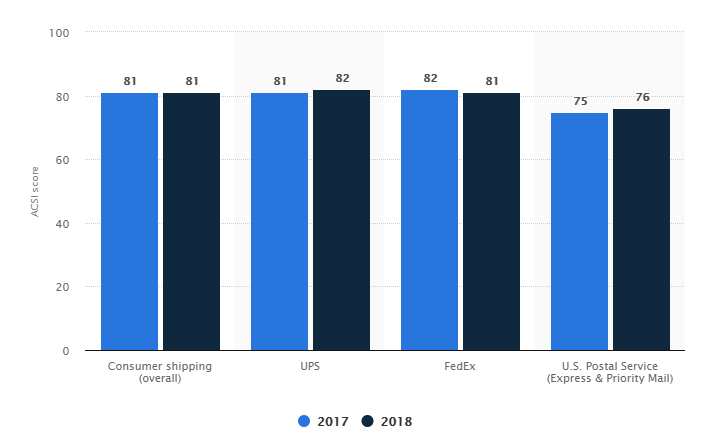
The keyword for success in this scenario is flexibility. Logistics operators need to offer personalized experiences to multiple segments of customers. Using a logistics management software that can automate the process of projecting different services to different customers can not only save time and effort on the managerial level but also bring added accuracy to data compilation and compliance.
Related Case Study: A constantly growing market like logistics cannot be managed only from a single device. How mobility solutions can ease logistics management and reduce its challenges is a read worthwhile. Find out more on iOS and Android development for logistics and supply chain company.
-
Manpower Management
Manpower is the trickiest of management responsibilities. You must maintain a humane approach toward the employees while keeping the best interest of your organization in mind. That can be a complicated equation in any managerial setup, but especially so in case of logistics management, as the drivers and staff are often placed in different geographic locations to maintain swift supply chain velocity. Decentralization of responsibilities, by appointing logistics managers in key locations, with appropriate work-order management solutions can help in more efficient management. For instance, work order software like ReachOut, helps logistics managers manage team utilization, team schedules, show proof of work, generate quotes and invoices and do much more. Managers can easily keep everyone on the same page and notify the staffs immediately about changes or provide them with live info they need.
The future of supply chain management How will technology and AI shape tomorrow [Source: University of Liverpool Online]
-
Compliance with Regulations
Transportation rules, regulations and security norms can vary from city to city, state to state, and quite obviously, from country to country. If you are a business catering to a global clientele, keeping up with these varying rules and regulations and familiarizing your staff with these, can pose a grave challenge. Collaborating with an efficient audit software can help eliminate these pains and improve your compliance, audit results and lead to quality investigations, thereby saving you from the trouble of getting on the wrong side of the law.

With the landscape of business operations continually changing, there is a shift in the ensuing challenges as well. Staying abreast with these changes and taking preemptive measure to ward off these challenges, is a sign of sound logistics management. However, solving logistic issues is not an impossible mission. Focusing on 3 major factors- Data, Process and Technology, can solve the biggest challenges of logistics.
For prompt and apt logistic solutions and to enhance your technology adoption in logistics, get in touch with Fingent now!
Stay up to date on what's new

Featured Blogs
Stay up to date on
what's new



Talk To Our Experts
Artificial Intelligence is revolutionizing our lives. What used to conjure up images of robots taking over the world, is now a household word. Recommendation engines are reading our minds, virtual assistants are listening to our voices, and AI insights are transforming our businesses. AI is definitely here, and this blog will show you how.
Artificial Intelligence and Its Impact on Today’s World
Artificial Intelligence in its basic sense is defined as intelligence demonstrated by machines. In application, we can say that Artificial Intelligence is the ability of a machine to assimilate information and use it to make intelligent decisions. The attributes of problem-solving, decision making and other cognitive abilities that are associated with humans becomes artificial intelligence when applied to a machine.
The lifeblood of AI is data and its pulse run by an algorithm. Algorithms assimilate data and make sense of it through analysis. The resulting insight is what drives the decision making and problem-solving capabilities of Artificial Intelligence. Learning is by far the greatest attribute of Artificial Intelligence. The ability to learn and emulate human thinking and behavior is what makes AI nearly unstoppable. Its application in business is unmatched and is predicted to offer $15.7 trillion to the global economy by 2030!
Advanced Benefits of AI
The benefits of AI extend to much more than recommendation engines and chatbots. The ability of AI to make sense of data collected through the Internet of Things (IoT) will be a game changer in every aspect of our lives. Gartner predicts that 20.4 billion “things” will be connected by 2020. Artificial Intelligence can analyze the data collected by IoT technology and enable it in ways that we cannot even imagine.
A classic example of this is Idemandu, one of the most talked about topic in the AI world since the 2018 Consumer Electronics Show. In the words of its founder Pooya Abka, Idemandu is the first AI agent “that can understand customers’ service needs over voice, connect them to vetted service providers instantly, and learn about their personal preferences with time.”
Demonstrating what is possible with Idemandu, a Forbes article quotes this conversation:
You: “Hey Idemandu, could you ask my massage therapist to come to my place tonight preferably after 8? I’m feeling an annoying pain in my neck.”
Idemandu: “Sure, but your therapist is not available tonight. I found another very similar therapist who is available, would you like to see him at 8 pm tonight? If not, I can book your own therapist for tomorrow at 8:30 pm.”
You: “Okay, tell him to come tonight.”
Idemandu: “Okay, he’ll be there. I already briefed him about your pain.”
Imagine the possibilities with such an AI empowered assistant in every home and business. Google Duplex is another technology that is focused on helping us make hotel reservations. The Assistant will call your chosen restaurant, converse with the concierge, make a reservation for you, confirm with you if the reservation was successful or recommend another restaurant if it wasn’t!
The ability of AI and robotics to use concepts like AI-Augmented Contextual Analytics and Sentiment Analysis to better predict and direct customer experience was brought out in one of our recent blogs. You can read it here: https://www.fingent.com/uk/blog/how-robotics-and-ai-can-improve-customer-experience-ctos-guide
How AI Is Transforming Various Business Sectors
The biggest impact of AI is in business. A survey conducted at the EmTech Digital conference revealed that respondents saw AI affecting these top three business outcomes:
- improve and/or develop new products and services
- achieve cost efficiencies and streamline business operations
- accelerate decision-making
We can see this impact in nearly every sector in business. Here are three sectors where the impact of AI has been seen the most:
Healthcare
86% of healthcare provider organizations, life science companies, and health technology vendors are using AI technology, says a 2016 report from CB Insights. These organizations are projected to spend an average of $54 million on AI projects by 2020. Few areas where AI is being used in healthcare are:
1) Data management – Medical records and other patient data can be accurately analyzed, stored and used to provide healthcare businesses with the right information at the right time. Time-intensive report analyses can be automated, diagnosis can be fast-tracked, and treatment can be better administered.
2) Virtual Consultation and Care – Healthcare apps using AI allow doctors, patients and, caregivers to communicate and coordinate effectively. Speech recognition, machine perception, and other AI enabled technologies, help to monitor the patient’s condition and administer effective treatment.
3) Precision Medicine and Drug Discovery – By screening complex compounds and existing medicines for specific attributes, drug candidates for pre-clinical drug discovery and development can be rapidly identified. AI can also help detect diseases and predict hereditary health issues more accurately and help design precision medicines for specific genetic make-ups.
For more applications of AI in the healthcare industry: https://www.fingent.com/uk/blog/5-ways-big-data-is-changing-the-healthcare-industry
Finance
The assimilation and analysis of financial data is where AI shows its true potential, but there is much more that AI can do in the financial sector. AI in the Finance industry reduces costs, saves time and improves accuracy and efficiency in all areas of Finance. Here are a few applications:
- Security from Fraud – Security is the number one concern in the financial sector. AI helps in this by simulating fraud and cybercrime scenarios and coming up with preemptive security measures to combat security breaches. AI also helps in monitoring whether all security measures and regulations are being followed in the design of financial technology.
- Wealth Management – AI engines help analyze data associated with wealth management and provide insights on how to provide optimal benefits to clients. Creating personalized and tax-optimized investment offerings for clients becomes much simpler and accurate with the help of AI. AI also helps mitigate the unpredictability of the stock market, by incorporating features like blockchains and distributed ledgers.
- Digital Assistants – AI now assists with banking transactions and finance in nearly every household. AI assistants like Alexa, Siri and others are used to make financial transactions. Voice assisted banking is being made possible with banks like Barclays coming up with technology to enable money transfer through voice assistance software.
Read more about how predictive algorithms and AI will rule financial services: https://www.fingent.com/uk/blog/how-predictive-algorithms-and-ai-will-rule-financial-services
Transportation
AI is being used widely in the transportation sector and these are a few areas where it is making an impact:
- Automation – While driverless cars are what comes to mind when we talk about AI and automation, the role of AI in automobile manufacturing is of equal import. Tesla’s automated manufacturing systems in its factories is an excellent example of the capabilities of AI in automobile manufacturing.
- Cloud based conveniences – With the help of AI and cloud computing, automobiles are being packed with features like suggestions for gas stations when the fuel is low, favorite restaurants on the route and shopping reminders when approaching stores.
- Intelligent Maintenance – Features like predictive maintenance, repair scheduling, and even sensors to detect medical emergencies for drivers can be enabled with AI.
Read more about how connected transportation will disrupt the world: https://www.fingent.com/uk/blog/how-connected-transportation-will-disrupt-the-world
Keeping up with AI
As you can see, the implications for AI in business is tremendous. It is important that businesses capitalize on AI-based technologies to keep up with the competition. Fingent has helped businesses from every sector to implement AI and drive revenue. Drop us a message if you have any questions!
Stay up to date on what's new

Featured Blogs
Stay up to date on
what's new



Talk To Our Experts
The Internet holds over 1.8 billion websites as of today. Out of this big mix, the number of active websites is no less than 644 million. What is equally startling is that more than one-quarter of them are powered by WordPress. Starting off in 2003, WordPress has evolved down the line from a blogging platform to the world’s most popular open-source content management system.
From its first version 0.7 to the current 5.0.1, much has changed. Refined UI, the introduction of plugins, widgets, streamlined dashboards and an array of new features. When it comes to 2018, WordPress is much more than a typical CMS platform. Most businesses now run their websites on WordPress whether in e-commerce, LMS, marketplace etc.
It is easy to use and economical, which is why most businesses prefer WordPress over other CMS platforms. WordPress is 100% customizable allowing businesses to optimize their website or blog for easy discovery and indexing by search engines. Moreover, WordPress sites are perfectly scalable and feature extended functionality with the addition of plugins.
With a string of new releases on their way, WordPress is further broadening its scope. To really understand how, here are 33 astonishing facts about WordPress in 2019.
33 amazing facts about WordPress in 2019
1) WordPress Drives One-Quarter of the Internet
WordPress powers nearly 32.5 % of all the websites on the Internet, which means nearly one out of three websites that you have visited is built with WordPress. That is to say, about 75 million websites now run entirely on WordPress.
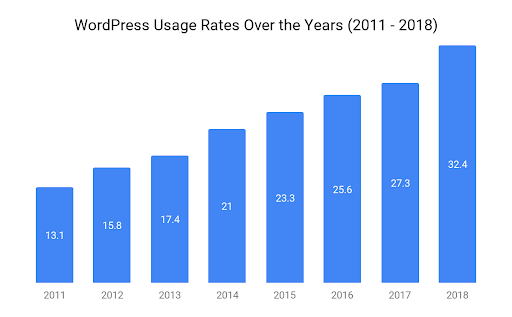
Source – W3Techs
2) WordPress is Growing Ahead of its Competitors
WordPress attained an astonishing 4 % growth from 2017 to 2018 according to a study made by W3Techs. It clearly establishes that WordPress’s market growth increased by 4% in the past year.
Meanwhile, WordPress’s competitors’ growth diminished in the same year.
- Joomla’s market share actually decreased from 3.4% to 3.1%
- Drupal’s market share decreased from 2.2% to 2.1%
3) Google Trends Data Shows Growing Popularity of WordPress
From the worldwide Google Trends data of the past year, you can see how popular is WordPress compared to other competitor CMS platforms like Joomla, Drupal, Magento, and Shopify.

Source: Google Trends
4) Woocommerce Plugin has a Remarkable Market Share
WooCommerce, the eCommerce plugin for WordPress powers about 29% of all the eCommerce sites on the Internet according to Datanyze. According to the same, WooCommerce has a market share of 21% across all the eCommerce websites in the world.
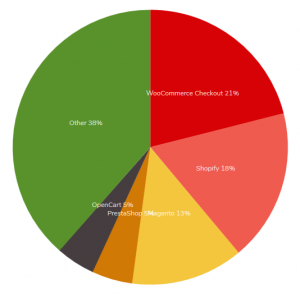
Source: BuiltWith
We worked with WooCommerce to build an e-commerce platform for one of our clients, Homeschool. It is a platform that provided users with high-quality educational resources that they can purchase or read online. Moreover, we also used WordPress to build an e-commerce website for VKC, one of the largest footwear manufacturing company in India.
5) “WordPress” Keyword has High Search Volumes in Google
In fact, the popularity of WordPress has peaked in recent times that it clearly has gained an upper hand in the search volumes of search engines. The keyword “WordPress” has around 1M-10M average monthly search volume in Google, which is 10 times the search volume for keywords of “Drupal” and “PHP”.
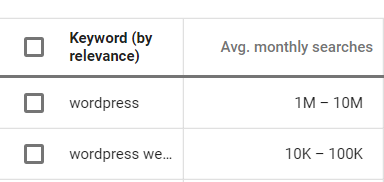
6) WordPress Leads in Global CMS Market Share
WordPress owns nearly 60% of the global CMS market share according to a report by W3Techs.

Joomla comes as the next competitor to WordPress with a market share of 6% followed by Drupal with 3.6%.
7) WordPress is Available in more than 80 Languages
Being a complete CMS solution, it is no wonder that WordPress packs more language support than its close competitors. WordPress contains translations for over 167 languages. Out of that, currently, 32 locales run full translations worldwide and has 58 up to date locales.
More languages are added by a team of independent collaborators as we write this to further extend the language support offered at WordPress. Very shortly, WordPress will cover almost all the major languages across different regions of the world to enable anyone to write, edit and publish content online from anywhere.
8) 56,319 Plugins and Counting
WordPress does have around 56,319 free plugins in their repository. That is by far one of its biggest advantages, which can be summed down to one word, extensibility.
The sheer number of plugins, both free and paid is what sets WordPress apart from its competitors. The WordPress plugin repository is growing each day as new plugins are added on a continual basis.
Besides, one can easily build their own custom plugins as is the case with one of our projects. We built a unique custom WordPress plugin for the Australian Retailer Association to help them manage events from a single interface.
9) Alexa Ranks WordPress High
As per Alexa, WordPress.com is the 57th most popular website in the world, or in other words, WordPress.com is popular than Pinterest, Github and CNN.

Source: Alexa
10) A Single WordPress Theme Churned Out Millions
One single WordPress theme Avada has generated more than 27 Million USD in revenue. It became the highest selling multi-purpose theme and the most downloaded on ThemeForest.
Custom themes are yet another key attribute of WordPress. As we have mentioned earlier, our work on a custom plugin for one of our client did not stop with that. Our team developed a custom responsive WordPress theme that revamped their website for better load and render times.
11) WordPress is Behind Big Brands
Lots of big brands use WordPress. It may be surprising that an open source CMS has such a high number of valued users from various businesses. Here are some of the top brands using WordPress to manage and publish their content online.

12) A Swift, Responsive and Redefined WordPress with Calypso
Calypso is the new JavaScript and API driven interface for WordPress.com. It is a highly powerful interface with lots of futuristic features that simplify how we manage websites. Calypso includes multi-site support with better page loading speed by utilizing the REST API and WordPress JavaScript.
Calypso is available as a downloadable application from WordPress.com that utilize its interface on computers running on Windows, Mac, and Linux operating systems. The responsive design offers a streamlined user experience that makes it a very user-friendly platform for managing websites.
13) Gutenberg – An Entirely New WordPress Experience
Gutenberg is the new react driven revolutionary editor of WordPress. It is said to be a radical step in the future of WordPress giving a whole new disruptive editing experience, especially for media-rich web pages.
Creating rich and engaging content is made easier with Gutenberg’s refined interface. It includes new tools like blocks that help users with even basic technical knowledge stylize and rearrange multimedia content effortlessly. Gutenberg will be the default editor of WordPress from version 5.0(which is set to release soon).
14) Moz lists WordPress in its Top 500
Moz in its Top 500 domains, lists WordPress.org as the 7th most popular website in the world. WordPress.com follows close behind, ranked 10th in the list.
15) 4,300,000 downloads for a Single Premium WordPress Plugin
Wpbakery Page Builder is a premium WordPress plugin with more than 4,300,000 installations.
16) Wix Once Stole WordPress Code
Wix, one of the biggest competitor of WordPress actually once stole GPL code from WordPress. The result was several allegations made by Automattic founder Matt Mullenweg against Wix of stealing their open source under the GNU Public License (GPL) code without any attribution, credit or license. Wix CEO, responded back that they indeed used WordPress code citing it as open source and free to use.
17) Yoast is Still the most Popular WordPress Plugin
Yoast, the SEO plugin of WordPress alone has more than 5 million installations. Around since 2008, Yoast has been the favorite plugin of countless users for implementing effective SEO strategies that earn them a notable place in the search results.
18) Plugin Installations is the Highest on WordPress
Around 35+ WordPress plugins have more than 1 million active installations. When looking at WordPress.org the number of plugin downloads have exceeded 1 billion.
19) The Most Vulnerable CMS on the Planet
Security is one weak string that WordPress has long struggled with. Data suggests that nearly 60% of WordPress sites are affected by security vulnerabilities caused due to an outdated or poorly coded WordPress plugin or theme. Around 8% of WordPress sites were hacked due to a weak password.
This is, however, not a sign of weakness of the CMS platform. Out of date versions and plugins have been identified as the leading causes behind the vulnerabilities that affect the platform such as hacking and malware attacks.
20) WordPress Hosts an Amazing Global Community
At the heart of WordPress is a large community dispersed globally who collaborates and contribute to making the platform better. WordCamps is one such, which are local conferences that covers everything about WordPress.
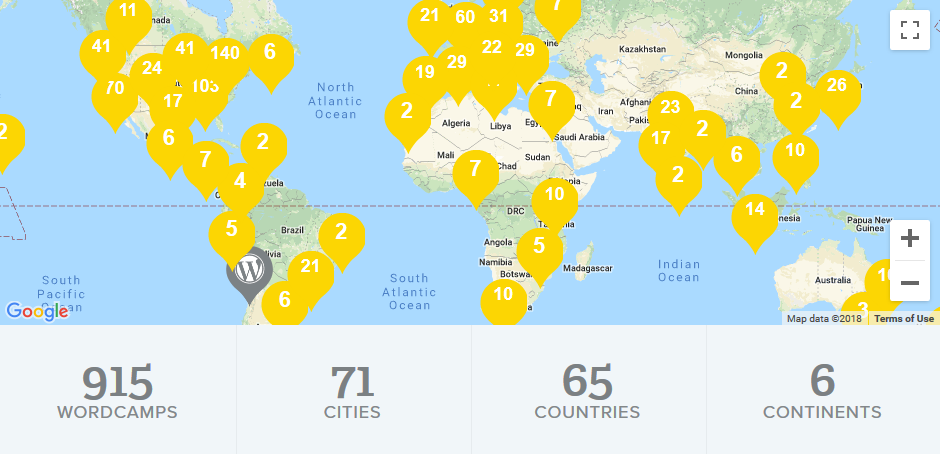
As of now, around 915 WordCamps have been organized in 65 countries and 71 cities across 6 continents. It brings together developers all over with sessions and activities to find ways to more effectively use WordPress.
21) A Majority of Educational Institutions Use WordPress
44.8% of colleges, schools, and universities all over the world use WordPress.
- Harvard Blogs
- MIT
- Northwestern University
- Boston University
- University of Berlin
- University of Melbourne
- Oregon State University Blogs
22) WordPress is Used by Governments All Over The World
WordPress powers thousands of government websites in all parts of the world. The list includes dozens of US Federal and State government websites, counties, small towns, high schools, etc.
Government websites like America.gov, Congressional Budget Office, Library of Congress, Brazilian Culture Ministry etc. are some that are run entirely using WordPress.
23) WordPress.com is not the Same as WordPress.org
WordPress.org(self-hosted WordPress) is the actual open source WordPress software. Anyone can download, install, modify and host it anywhere.
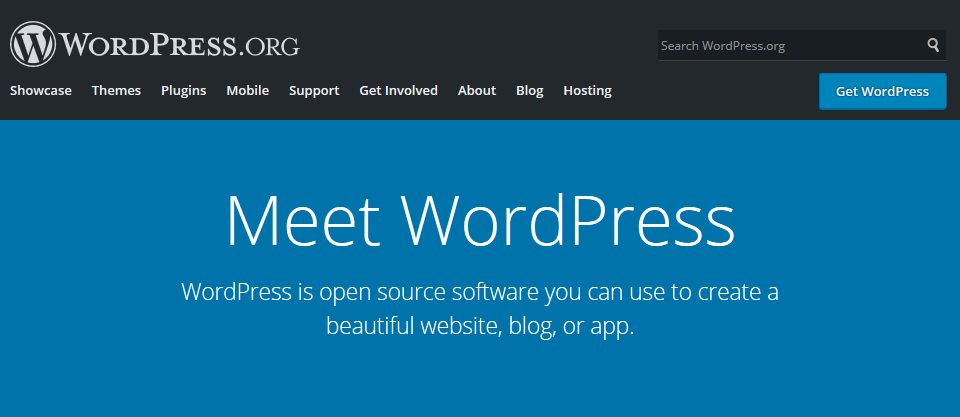
WordPress.com is the “website-as-a-service” implementation built on the WordPress.org software. WordPress.com hosts your site and handles everything for you.

24) WordPress versions are Named after Jazz Musicians
WordPress core developers share a love of jazz music, and since WordPress 1.0 all major releases are named in honor of jazz musicians they admire.
25) GNU GPL Licenses WordPress
WordPress is released under GNU GPL which means you have the freedom to,
- Run the program for any purpose.
- Study how the program works and change it to make it do what you wish.
- Redistribute copies so that you can help your neighbor.
- Improve the program and release your improvements (and modified versions in general) to the public, so that the whole community benefits.
Getting started with WordPress [Source : LearnWebCode]
26) WordPress has only 822 Employees
WordPress has only around 822 employees around the world which is 1/700 of the total employees in Amazon.
| Website | Monthly Visits | Employees |
| Amazon.com | 199M | 575,700 |
| WordPress.com | 147M | 822 |
| eBay.com | 104M | 14,100 |
You can also see that, even though eBay has much less traffic compared to WordPress, they do have 17 times more employees than WordPress.
27) Content Keeps Pouring Out from WordPress
Users produce about 69.3 million new WordPress posts and 72.0 million new comments each month. By looking at the live activity, we can infer the amount of usage at different countries.
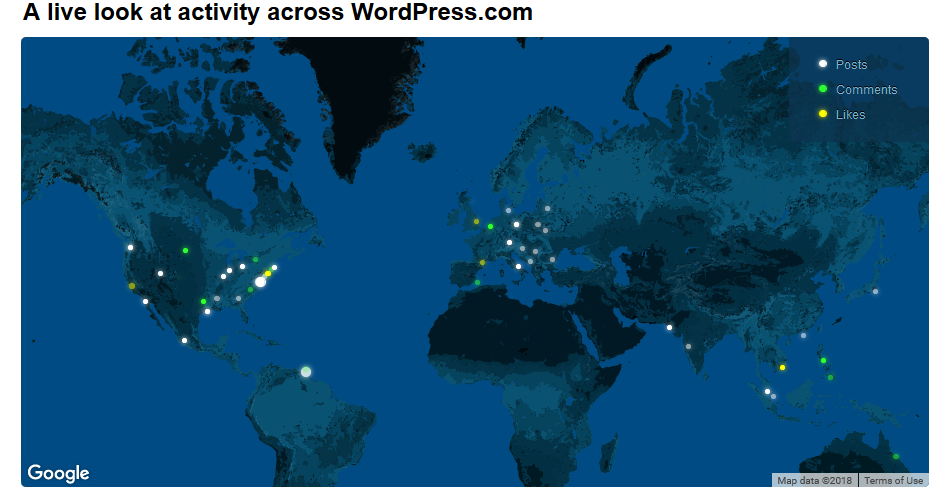
28) More WordPress Versions in a Short Span
More than 98 versions of WordPress has been released till now. The development community has been quick in coming up with redefined versions to help make WordPress better and an all-encompassing CMS system open to everyone.
29) WordPress Once Passed off as a Necessary Job Skill
WordPress was the most requested job skill in the world in 2014. For developers, having a handful of WordPress skills like writing, publishing and managing content on the platform were viewed as necessary to land a job in the information technology sector.
30) WordPress Surpassed Amazon in Visits One Time
Some years back, WordPress.com had more visits than amazon.com. The popularity of the CMS platform has reached its peak that it now gathers more visits than any other websites belonging to different categories.
31) You can Setup a WordPress Website in 5 Minutes
WordPress does have the famous 5-minute installation setup, which means you can launch your first WordPress website fully ready in just 5 minutes.
32) A WordPress Plugin Akismet is Catching more Spam than Ever
Akismet, the spam blocking WordPress plugin catches 7,500,000 pieces of spam per hour. As of now, Akismet has succeeded in blocking about 456, 455, 260, 375 spam comments from the web. Several websites integrate Akismet into their WordPress to deal with spam worry free.
33) WordPress has its own Merchandise Store
The official merchandise store of WordPress has been named as Swag Store. It sells a range of WordPress merchandise from t-shirts, coffee mugs, sweatshirts, sunglasses, carry bags and skullcaps.

Summing Up
From individual bloggers to big companies, WordPress helps them share their passions, promote their company’s products and engage with a wider audience. Being a step ahead of its competitors, WordPress puts forth what an ideal CMS platform should be like. Open source and an extensive collaborative community that strives to make it better with each new releases and updates.
For this reason, we at Fingent rely extensively on WordPress to create, publish and manage all our digital content as well as use it across different projects to serve the requirements of our clients. The conciseness and extended capabilities of WordPress ensure that digital publishing and management is more swift and easier than before.
We can help you with the same as our expertise in WordPress can give your business a solid online identity that will push your content across a wider audience and distribute your marketing efforts more effectively.
Stay up to date on what's new

Featured Blogs
Stay up to date on
what's new



Talk To Our Experts
Today’s consumers are tech-savvy, demand consistency and know they can switch brands at any time. Therefore, Customer Experience (CX) is extremely important now more than ever. Customers aren’t just buying a product. They are looking to gain a good experience throughout the customer journey – before, during and after their purchase.
Imagine the pressure of not slipping up in any instance! If it wasn’t for AI and robotics, this could be a daunting affair. Thankfully though, the application of robotics and AI has streamlined the entire customer journey. As a CTO, leading the company towards this technological transformation is a great responsibility. This blog will take you through 4 ways in which robotics and AI can improve customer experience.
1. Personalization
Hyperconnected customers of this digital age highly value personalization. This personalization is expected at all touch points and marketers are employing various strategies to achieve this. In the basic sense, this includes presenting personalized recommendations using algorithms and predictive analytics. Algorithms mine transaction data, browsing patterns and purchasing behaviors to gain customer insight. This information then enables to design personalized offers and create cross-sell opportunities.
Machine Learning is going one step further with AI-Augmented Contextual Analytics. Contextual Awareness is made available through machine learning and human curation. This awareness is implemented across the entire data and analytics workflow of the company. Thus, personalization is made possible throughout the operations and can be implemented at any touch point.
Sentiment Analysis is the next big thing that companies are implementing in order to improve customer experience. Voice, text and visual engagement can be analyzed by technologies to gauge sentiment and emotion. Voice biometrics over phone calls, parsing of facial expressions during video chats, and texts through chatbots can be used to understand emotion and intent. This insight helps companies measure and deliver customer satisfaction more effectively.
Read More: Predictive Analytics: The Key to Effective Marketing and Personalization
2. Improving Internal Processes
As we have discussed, customers expect a satisfactory experience in all touch points. This includes the way the company is run, the backend and the corporate image. Efficient processes and effective decision-making filters down to a profitable company and happy customers. AI and robotics can be used to achieve this.
Mark Robinson, co-founder of the world leading SaaS solution Kimble talks about how augmented intelligence helps businesses grow. “Using augmented intelligence to make suggestions to staff, and to record their response, means that humans and the machines can work together to come up with the best solutions,” he says. “There is less need to worry that people are going to miss important actions or take wrong decisions because of the visibility of what’s going on.”
It is believed that AI has the power to increase productivity by 40% or more by 2035. By automating processes and supporting innovation, AI can improve manufacturing and business processes. One example is smart product ordering systems, which use the power of AI to streamline order fulfillment. Our recent blog brought out the opportunities in this: “From ensuring that the product is personalized and available where the customer wants it, to streamlining the order shipment and delivery process, the customer experience is enhanced by the intelligent product ordering system.”
3. Effective Pricing
“What I ‘charge’ today has nothing to do with yesterday or tomorrow. It has to do with ‘now’!”
– David Wayne Wilson
This has profound significance today, where pricing drops or increases by the second. However great your marketing, your technology and other systems are, it all comes down to pricing. If a consumer gets the same benefits and quality at a lesser cost, he will opt for a cheaper option. Pricing is therefore a vital component in competitive advantage. This means that businesses must keep a close eye on competitors’ pricing behavior.
That is where Dynamic Pricing Science holds significance. With the power of Artificial Intelligence, cognitive algorithms, big data and machine learning, businesses can now effectively adjust their pricing strategies in real-time. Dynamic Pricing Science enables tailor-made pricing solutions to customers at the right time and consistent across channels. It helps understand buying patterns, identify effective correlations, compare competitor prices, match it across channels and create a customized offer – all in real time.
4. Improving Response Time
Response time is crucial in business. This is true in leads conversion as well as customer service. The importance of response time in lead conversion was brought out by Dave Elkington, the CEO and founder of InsideSales.com. Quoting a study he was involved in he says: “The study revealed that the odds of making contact with a new lead are extremely high if you call within the first 5 minutes of submission … a rep is 100x less likely to make contact if the first call is made 30 minutes after submission. The odds of making contact drop by 3000x if the first call is made 5 hours after lead submission.” Converting a lead into a customer is the first customer touch point and it is vital to get it right.
This is important in customer service as well. The State of Multichannel Customer Service report found that:
- 68% of people stop doing business with a brand due to a poor customer service experience.
- 34% of people feel that quick resolution of their problems was the most important feature of customer service.
- 61% of people on social media expect a response from a brand in less than 24 hours.
A bad response time could break a business as the numbers show. However, AI and machine learning have helped immensely in this regard. Chatbots are proving to be a great boon, especially when it comes to swift response on first-level queries. This ensures that there is an immediate response and minimizes time spent by personnel on repetitive queries. Agents can then handle deeper conversations and conversions with the assistance of AI.
China Merchants Bank is an excellent case study on the effectiveness of real-time chatbot interaction. Interactions through these bots had reached a record of 41 million by the end of 2015, with the chatbot handling 99.5% of the questions with an accuracy of 99.8%!
Power Your Customer Service With AI
As you can see, the power of AI and robotics in customer service cannot be overemphasized. Fingent works with clients across industries all over the globe. We would be happy to help you with any questions you might have. Drop us a message and let’s get this rolling.
Stay up to date on what's new

Featured Blogs
Stay up to date on
what's new



Talk To Our Experts
The need to be “smart” is no more an option for businesses. Keeping up with the competition has never been harder nor has the pace of technology ever been faster than it is today. Hence, the question that arises is this: Is there a need to switch to smart product ordering systems? Won’t existing systems do the job just as well?
These are some reasonable questions for businesses to ask today and this blog will help you answer them.
Why Change?
Getting right to the point, let’s consider what has changed in the retail space that necessitates a change to smart product ordering systems. Rising demands from the empowered digital customer, the need for personalization, customized products and value-based experience, increased customer base and emerging markets, changing trends and consumption patterns – all these factors demand an ordering system that is technology-driven and agile.
Oracle Corporation and Capgemini recently conducted a study of 589 top supply chain executives in connection with the order fulfillment process. The study surmises that “order fulfillment processes are, in fact, becoming more intricate and that inventory management and delivery performance is slipping.” This has steep consequences as the report continues: “Customer satisfaction and retention are put at risk and businesses are forced to allocate additional spending on resources and labor to address the situation. This, coupled with the rising price of raw materials and mounting transportation costs, are seen as a growing threat to the bottom line of businesses everywhere.”

The writing is on the wall. Smart product ordering systems are vital to the survival of businesses. There is no getting around it. Though this is the verdict, it is a big decision with a significant impact on your processes, employees and your business. This calls for a deep-dive into what these smart product ordering systems are, the benefits and the impact it has on retailers and wholesalers like you. Let’s walk you through it.
What are Smart Product Ordering Systems
An order management system (OMS) is the backbone of a retail operation. It orchestrates the complete process right from processing customer orders, to fulfillment and shipping. This involves tracking the status of the order at all points and seamlessly connecting the information to the relevant systems and resources in the organization. While this is the function of a traditional OMS, a smart product ordering system does more, much more.

A smart product ordering system is intelligent and empowers your order management with the power of automated technology. Here is listing a few benefits to retailers and wholesalers:
-
Organizes and streamlines the order fulfillment process
A smart product ordering system will create a unified system for all your data and processes. Having information on inventory levels, orders, sales forecasts and analytics continuously updated in one centralized location would help you make intelligent and instant decisions in real time. This streamlines the entire process giving you the ability to strategize better and never miss a beat on the pulse of your business.
-
Fulfilling an Omnichannel Demand
Retailers and wholesalers have the power of multiple shopping platforms at their disposal. While this incrementally improves visibility and sales, it also requires a much more intelligent omnichannel order management system to handle these orders. A smart product ordering system helps you find the best way to fulfill your orders by evaluating all these channels and supply sources. By synchronizing information on warehouse and store locations, shipment costs and inventory details, the system automates sourcing and allocation decisions without the need for constant manual intervention.
-
Insights and analytics
Powered by Artificial Intelligence, the opportunities for a smart product ordering system is endless. With insights on customer behavior and analysis of historical data, businesses will have the ability to gauge buying and purchase decision patterns, channel preferences, inventory planning, marketing campaigns, staffing, and every aspect of their business.
-
Consistent Customer Experience
Today’s consumers expect a completely unified experience. They look for consistency in their shopping experience with no room for a slip in the product, price, service, delivery and after-sales support. This becomes further complicated when catering to an omnichannel demand. Accenture’s KMI Insights To Conquer The-Omni Channel Imperative report says that “what leaders are getting right is not single-threaded. They are creating experiences that are truly centered on the customer, and they are thoughtfully connecting the dots across their organization from product to people to process to platforms in order to delight their customers and their employees.”
This is what customers expect. They want a seamless experience in all touch points. However, with “buy online, pick up in store” and other options available in an omnichannel business, it is becoming increasingly difficult to “connect the dots.” A smart product ordering system takes the complexity out of the process by fully automating order fulfillment. From ensuring that the product is personalized and available where the customer wants it, to streamlining the order shipment and delivery process, the customer experience is enhanced by the intelligent product ordering system.
Read: How product ordering system integration with CRM helps in purchasing?
The Possibilities
Think about what a smart product ordering system can practically do for the customer experience and your business.
- Shopping enhanced – a smart product ordering system will provide insight into the buying patterns of your customers and enable a personalized shopping experience. Your inventory numbers are clearly reflected in your product catalog. This way, customers aren’t left dissatisfied with a lack of products after they purchase them online. The system will also be able to capture the point of exit, abandoned cart items and search history to enable an effective conversion. Automation of order entry inputs through Smart OCRs enables Intelligent Indexing, training the system to find the shipping address and other information automatically for the next purchase.
- Processing made easy – By synchronizing the order information with your inventory and shipping process automatically, the smart product ordering system ensures intelligent sourcing and allocation. By simultaneously syncing these details with your sales and marketing functions, the system enables accurate sales forecasting and effective marketing insights for the future.
- Payment in a click– Integrations with billing and accounting systems ensure that the checkout process is seamless. A smart product ordering system will be able to recall customer details and enable quick payment verification thereby reducing the time to check out and enhancing customer experience.
- Shipping and Delivery streamlined – By optimizing sourcing and allocation, and automatically updating shipping and delivery partners with the order details, a smart product system will make sure there are no glitches in delivery.
Imagine how organized your business could be if you had the right smart product ordering system. And yet many retailers and wholesalers do not have the capabilities to make this happen. According to the Capgemini study mentioned at the outset, 38% of respondents said that the company lacked the software capabilities to handle multi-channel orders. 34% said that they lacked the software integration needed to fulfill orders across channels.
This is where we can help you. Fingent works with retailers and wholesalers to equip their business with the software capabilities to ensure a seamless order fulfillment and customer experience. Let us know if you have any questions and we would be happy to help.
Stay up to date on what's new

Featured Blogs
Stay up to date on
what's new



Talk To Our Experts
Custom Software Development Vs Packaged Software – Tips to select the right solution for your business
Custom software and off-the-shelf solutions come with their own pros and cons. Organizations should assess their requirements closely and opt for one that suits their workflows and processes.
In this video, Dileep Jacob, Head of Operations at Fingent shares his insights on helping businesses choose between off-the-shelf and custom software offerings. He elucidates on how custom software and off-the-shelf solutions bring efficiency improvements within an organization. The benefits and limitations of the two platforms are dealt with to help pick the best choice for your business.
Conclusion
Businesses find it difficult to choose between off-the-shelf or custom software solutions. This video presents a clear picture of the key differences between the two together with their pros and cons to help businesses like yours pick the right choice. Fingent’s decade-long expertise in custom software development can assist you to make an informed decision by piecing together the best solution and guide in your decision making.
Questions? Comments? Concerns? Contact us today to learn more about how we can help drive your business success with custom software solutions. We will quickly get back to you with the information you need.
Stay up to date on what's new

Featured Blogs
Stay up to date on
what's new



Talk To Our Experts
 INFINCE was showcased at the NY Business Expo held on October 30, 2018, at the Jacob K. Javits Convention Center in New York. The New York Business Expo is an annual B2B trade show for small and mid-sized businesses. The expo brings together business owners and executives of small companies who converge on this day-long event with conferences, sessions, and networking.
INFINCE was showcased at the NY Business Expo held on October 30, 2018, at the Jacob K. Javits Convention Center in New York. The New York Business Expo is an annual B2B trade show for small and mid-sized businesses. The expo brings together business owners and executives of small companies who converge on this day-long event with conferences, sessions, and networking.
As a part of the exhibition, Stephen Cummings, the Senior Vice President at Fingent, took to the stage to deliver a session on running profitable small businesses in the age of digital technologies. He elaborated on how small-scale businesses can be empowered with technology to become competitive and highly productive to thrive in today’s market.
“Every company today, one way or another, depends on information. Successful companies are resilient and adopt the right mix of technology and processes as their appetite for information technology grows. We’ll present ways a small business can take advantage of recent advances in technology to compete more effectively, even against much larger companies.”
– Stephen Cummings, SVP, Fingent
Small Businesses and Technology
Technology should remain accessible to businesses of all kinds, whether big or small. Stephen highlighted on this very aspect in his 45-minute presentation. Technology comes with its own jargons that prevent smaller businesses from taking advantage. However, the onus is on bringing technology to businesses with smaller investments and workforce, so that they can thrive competitively.
There is a perceivable gap in adopting technology among small businesses. He attributes it to the increasing costs and lack of adequate tech support, Besides, on-premise IT infrastructure was dissuaded in favor of alternatives like the cloud, where small companies can get computing resources at reasonable costs. This is where Stephen put forth INFINCE, Fingent’s own enterprise cloud platform to the spotlight.
About INFINCE
INFINCE is cloud technology optimized for small businesses and a platform to run IT without any hassles. Stephen highlighted on some of the key traits of INFINCE that makes it different from other cloud platforms. Quick deployment is one such, where a company can set up and run INFINCE within minutes. INFINCE is also economical as it integrates optimal cloud configurations that cut down cost without sacrificing on performance.
INFINCE’s concierge IT services together with 24/7 support help small companies deploy the right technology. With it, small businesses get the advantage of a true enterprise cloud with all the functionalities at half the cost. In addition, the huge array of productivity tools and utility apps integrated with INFINCE helps automate marketing, improve customer engagement, open up collaboration across all levels and monitor workforce productivity through its streamlined dashboards.
About Fingent
Fingent is a global IT company specializing in developing custom software solutions that help businesses succeed. Starting operations in 2003, Fingent has grown over the years with more development centers spread across three countries. By building sustainable business practices across different industries, Fingent has become the preferred partner for leading enterprises like Sony, Johnson & Johnson, PwC etc. The industry expertise combined with a robust workforce have enabled us to consistently deliver strategic solutions for a global clientele.
Find out more about the NY Business Expo here
Stay up to date on what's new

Featured Blogs
Stay up to date on
what's new



Talk To Our Experts
What Machine Learning is and why it is important in business
Given the increasing prevalence of data today, machine learning has evolved rapidly to advance computing a step forward. Enabling computers to automatically learn and improve performance using data, ML is viewed as a disruptive technology with the potential to transform areas like enterprise, manufacturing, healthcare, e-commerce etc. Global ML adoption rates points to huge investments and diverse use cases in the coming years making it one key technology to focus your efforts.
This infographic focuses on the essentials of machine learning together with how it helps in uncovering insights from huge data stacks. Besides, its applications, global adoption rates, and future developments are also dealt with to give you a basic understanding of machine learning so that it can be put to use for uplifting your business processes and operations.

Deploying proper machine learning systems can uplift your business and maximize the ROI. Get in touch with us today to discover and implement the right machine learning solution that will transform your business altogether.
Stay up to date on what's new

Featured Blogs
Stay up to date on
what's new



Talk To Our Experts
AI continues to positively disrupt businesses around the world by empowering them with automation and data-driven insights.
In this video, Deepu Prakash, Head of Process and Technology Innovation at Fingent shares his expertise on deploying AI within the context of the modern business environment. He puts forth five crucial steps that you can begin right now to shift your company into an AI-driven model systematically.
Stay up to date on what's new

Featured Blogs
Stay up to date on
what's new



Talk To Our Experts
So, You– one of the key decision makers of your company, have a cool idea, a plan or a requirement for a software application, a mobile application for your business, a website, or need to automate an ineffective business process. You might have an overview of what you need, but can’t do it yourself, or you don’t know any good connections doing the job.
What would you do?
How will you choose that perfect custom software development company which can provide the best solutions among the millions of other custom software development firms out there? I am sure that you know there is a lot of difference between finding a software firm and finding the best software development company for your requirements.
The majority of the established firms out there are masters of their art providing excellent solutions and service. They are all well-experienced in creating software or applications from scratch to enterprise levels. Most of these have spent a considerable period in the industry, know the trends and are constantly striving in a market that is highly competitive and advancing day by day. So, how do you select that one provider from these many experts out there in the market? It’s indeed a very tricky job and should be done with caution. However, you will find great use of the points given below to select your right software outsourcing partner.
Identify your Needs
How can you choose the best when you don’t know what you want? Identify your business needs properly, talk to your employees, evaluate the problems and analyze the solution. Form an outline of the solution you want to meet the objectives. Depending on the nature of your project, the requirements and reputation choose offshore or onshore providers.
Check the Company’s Technical Skills and Expertise
Gather information about the company – the skill , knowledge of the team members and their portfolio working in the latest technologies in similar domain as yours, company’s experience handling projects in the particular niche/ domain, company’s skill in decoding your requirements into apt solution, the communication effectiveness, adherence to deadlines, and the like. Look for teams providing direct access to developers who can communicate well with you. Software houses with teams experienced in agile or hybrid agile methodologies are always better choices. Have casual getting to know each other kind of chats, but gather solid information in the course of your interaction, that clearly showcases their efficiency in previous works.
Check their Reputation with Others
Of course, you want to partner with the best custom software development company, but would you go for a company that is not polite and nice to work with? How scalable are their solutions? Know the company’s flexibility to get on with different atmospheres by looking at their client base and client relationship history. Check the clients’ and customers’ testimonials/reviews on platforms like Clutch, GoodFirms, etc. or connect with one of their clients through social media channels to know their opinion about the company, talk to real people via online forums, discussions and other social media to know their opinion, direct or indirect experience with this company. Doing these will sometimes leave you confused with overwhelming responses from different people, nevertheless, take an average of pros and cons and decide what cons can you overlook for better pros of the company that aligns with your requirements.
The Budget
Cost is always as important as the company’s expertise. Determine whether the cost of the project falls in your budget. Unless confident on the guaranteed ROIs, you don’t want to go bankrupt buying an over expensive software that automates parts of your business. That said, you don’t have to compromise on the quality of the software for low costs either. Certain companies price their solutions for the sheer fact of overcharging to seem like a bigger and better company. Do not forget to look for hidden or additional costs in the contract, like additional fees for documents management, annual setup/ maintenance in addition to monthly support charges, in-person training, etc.
Support your Core Business Functions with Efficient KPO Solutions.
Size of your Software Project
Is your project small, medium, large or huge? Not all companies undertake any size of custom software development projects. Certain software development companies commit only to big fishes, providing them giant, multi-year, million dollar projects. These are usually famous brands and industry experts. Whereas many smart small to medium size companies take multi-year projects. Such companies’ growth curve over a small period of time shall showcase their competency and potential. Has the company been growing fast or diminishing in size or stagnant over this period?
How Passionate are they to Develop the Solution
The company to which you outsource must understand your requirement in a way you understand and aspire to. Are they as passionate as you about this project? Are they completely dedicated to making a quality product or are they just doing a duty for money they take? These are evident from the way they suggest added features which can be included, future scopes for the product, or deny with an idea that is not quite useful. However, make sure they back their opinion with proper facts and reasons that convince you about their dedication and is not just to ‘make the task easy’ for them.
What happens in the Case of Divorce?
Jon Lincoln, business development specialist at Etfile says that, “Some vendors try shady tactics by holding your data hostage (as if they own it!) or charge an exorbitant amount to sway you from leaving”. Get proper agreement on safety and security issues and how you get your data back in case you leave the vendor. Expect some charges especially if the data was encrypted, but it shouldn’t make you bankrupt in any case.
Quality of After- Sale Support and Services:
Even the most perfect solutions guarantee only 99.9999% up-time. Unfortunately, there are no 100% perfect solutions. Even though too small, there is always a fraction of the chance that things might go wrong after delivery, especially in the case of software. So make sure your vendor company provides direct access to the technical team and offer good support, maintenance, cloud-based updates and upgrades and troubleshooting services for a fair period of time after sales.
Evaluate your Software Package Now!
Take a Test Drive
Most companies these days provide a free trial to ensure the quality of the features, benefits, and usability. Ensure that the software meets your requirements, have necessary features and functionality. During the trial, feel free to ask your vendor all the questions and doubts you may have.
Your first stepping stone to establishing your goal is choosing the right custom software development company. A fault here might lead to devastating results. So, take no chance, do thorough research and study based on the factors mentioned above. Based on our experience developing and deploying custom software for a wide range of industries and organizations of varying sizes, we believe that the Best Company is that which deliver a solution blending with your business process to the highest degree, within the stipulated cost and time and without a compromise on quality!
Stay up to date on what's new

Featured Blogs
Stay up to date on
what's new























